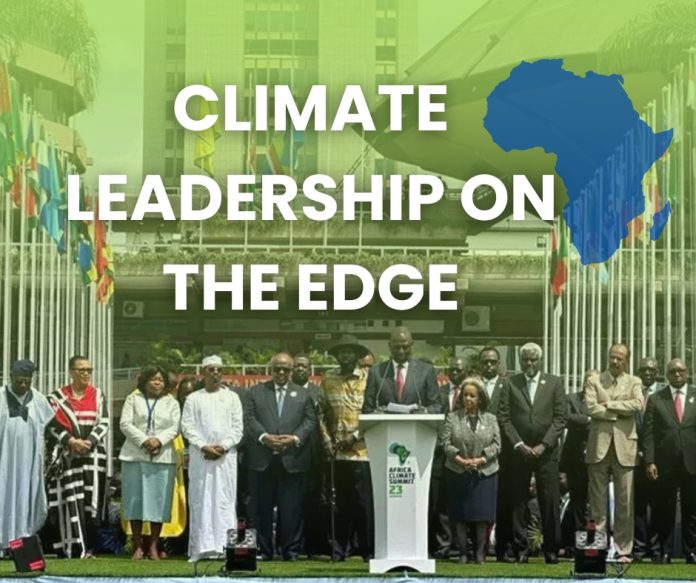Ethiopia has officially been awarded the bid to host the second Africa Climate Summit (ACS2), set to take place from September 8 to 10 in Addis Ababa. The announcement follows months of uncertainty after several countries declined the opportunity, citing logistical and financial constraints. The decision places Ethiopia at the center of Africa’s climate diplomacy – a great milestone for the country however, a critical paradox emerges. Can a nation beset by internal conflict, climate displacement, and fragile governance credibly spearhead Africa’s green agenda? The stakes couldn’t be higher.
Ethiopia is no stranger to crisis. Armed conflict in the Tigray region until November 2022 displaced over 2.7 million people, with the conflict contributing to a staggering 4.4 million internally displaced persons across the nation. According to OCHA, about 56% of these have been uprooted for more than a year. Climate disasters compound the problem: persistent droughts and flash floods displaced nearly half a million additional people
Despite a projected GDP growth of 8.9% and a 31% uptick in government spending to nearly 2 trillion birr (~$15 billion) for the 2025/26 fiscal year, the country grapples with humanitarian strain, food insecurity, and environmental stress.
Ethiopia’s flagship Green Legacy Initiative — launched in 2019 with an ambitious plan to restore national tree cover — has reported planting over 25 billion seedlings by end-2022, surpassing its 20-billion target. The initiative has created roughly 767,000 jobs, predominantly for women and youth, across more than 120,000 nurseries.
Ambition continues: a second phase aims to plant another 25 billion trees by 2026 . But critics warn that widespread tree-planting, while visually striking, isn’t enough—monitoring, species diversity, and long-term survival remain under-evaluated. Moreover, both the UN and the World Bank found no definitive evidence of CRGE-linked emissions reductions since the strategy’s inception.
Ethiopia’s Climate Resilient Green Economy (CRGE), conceived in 2011, sets a bold vision: decoupling growth from emissions to achieve middle-income status by 2025. Despite that, progress has been uneven. The government has channeled an estimated USD 8.2 billion annually into CRGE linked projects from 2011–2019, yet analysts warn of a USD 6.8 billion financing gap yearly until 2030. Further clarity is needed and Ethiopia still lacks a fully operational climate expenditure tracking system. UNFCCC reviews flagged unreliable data and poor emissions monitoring frameworks as persistent issues.
Read also: Ethiopia Launches National Policy to Encourage Walking and Cycling
In September 2023, Nairobi hosted the inaugural Africa Climate Summit, yielding the Nairobi Declaration, over USD 23 billion in pledged green funding, and a call for global carbon levies. Yet independent reviews paint a different picture: delivery faltered. Earth.Org described the summit as more “milestone” than movement, with few mechanisms to ensure promise fulfillment. Concrete figures on pledged to actualized funds remain elusive, raising concerns over transparency. Civil society contends that less than half of those funds have been mobilized, though precise data remains murky.
The second Africa Climate Summit (ACS2) presents a defining moment not just for Ethiopia, but for the continent as a whole—a test of whether Africa can move beyond climate symbolism to meaningful action. Ethiopia’s role as host carries institutional weight, reinforcing Africa’s commitment to homegrown solutions by anchoring the summit at the African Union’s headquarters in Addis Ababa and placing a green spotlight on the Horn of Africa. But the true challenge lies beneath the surface. Without clear evidence that Ethiopia’s Climate Resilient Green Economy (CRGE) strategy is delivering measurable outcomes, or that climate finance pipelines and displacement interventions are both credible and operational, the summit risks being remembered as a symbolic gesture rather than a substantive breakthrough.
To prevent this, a series of reforms must be embedded into the summit’s structure. First, public summit scorecards should be introduced to track every commitment made, detailing the funding source, project location, sector, and implementation status updated quarterly and made accessible to the public. This kind of transparent tracking, inspired by climate dashboards in Latin America, could help restore trust. Secondly, third-party audits involving civil society groups, the African Union, and UN agencies should assess whether the summit’s promises translate into real-world change, from emissions reductions to social protections for displaced communities.
Additionally, community-led monitoring using technologies such as drones and remote sensors—can offer real-time insights into forest regeneration, infrastructure development, and climate resilience on the ground. Finally, all pledges must be directly tied to Ethiopia’s national climate investment priorities, especially in critical sectors like reforestation, sustainable agriculture, and electric mobility. Only then can ACS2 rise above the pageantry of global summits and become a platform for tangible, accountable progress.
Ethiopia’s dual displacement crises—conflict and climate—are not abstract statistics; they represent 4.4 million displaced people amid humanitarian catastrophes. With famine risk looming in northern regions, failure to show progress during ACS2 may erode the summit’s credibility irrevocably.
Read also: Ethiopia Will Plant 5 Billion Trees This Year to Tackle Climate Change
Hosting ACS2 places Ethiopia in a high-stakes spotlight, it can emerge as the continent’s climate standard-bearer or highlight systemic failure. If Ethiopia demonstrates durable CRGE steps like securing USD 7.5billion/year in financing, creating measurable emissions reductions, and ensuring tree survival rates above 60%, then the summit could mark a turning point for African climate leadership.
The inaugural Africa Climate Summit in Nairobi revealed strong continental ambition for climate action but also exposed serious gaps between financial pledges and delivery capacity. While it achieved milestones like launching the African Green Credit Facility and integrating climate declarations into AU frameworks, progress remains fragile. As Ethiopia prepares to host ACS2, the focus must shift to implementation and accountability to avoid risks of reinforcing skepticism about Africa’s climate leadership and repeating a cycle of high-profile promises with little lasting impact.




